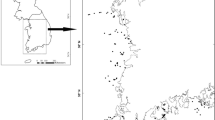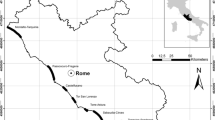Abstract
In a first step to investigate the potential source-sink functionof isolated mountains (i.e. inselbergs) in an arid landscape,affinities of inselberg floras with their surrounding were investigated in foursets of inselbergs in Namibia's Nama Karoo. The questions focussed on(a) the potential of inselbergs to serve as sources for degradedrangelands, and (b) the role of species attributes in the relationshipbetween inselberg and matrix. The study showed that inselbergs can serve assource for degraded rangeland, but at regional and landscape level employed inthis analysis, the species attributes growth form and seed dispersal did notprovide any conclusive trends.
Similar content being viewed by others
References
Auerbach M. and Shmida A. 1987. Spatial scale and the determinants of plant species richness. Trends Ecol. Evol. 2: 238-242.
Barthlott W., Gröger A. and Porembski S. 1993. Some remarks on the vegetation of tropical inselbergs: diversity and ecological differentiation. Biogeographica 69: 105-124.
Boeken B. and Shachak M. 1994. Desert plant communities in human-made patches - implications for management. Ecological Applications 4: 702-716.
Boeken B. and Shachak M. 1998. Colonization by annual plants of an experimentally altered desert landscape: source-sink relationships. J. Ecol. 86: 804-814.
Burke A. 1995. Geigeria alata in the Namib desert: seed heteromorphism in an extremely arid environment. J. Veg. Sci. 6: 473-478.
Burke A. 2002. Plant communities of a central Namib desert inselberg landscape. Appl. Veg. Sci. (submitted).
Burke A., Jürgens N. and Seely M.K. 1998. Floristic affinities of an inselberg in the southern Namib Desert - relic of the past, centre of endemism or nothing special? J. Biogeography 25: 311-317.
Carr M.R. 1997. PRIMER User Manual. Plymouth Marine Laboratory.
Chapin F.S., Osvaldo E.S., Burke I.C., Grime J.P., Hooper D.U., Lauenroth W.K. et al. 1998. Ecosystem consequences of changing biodiversity. BioScience 48: 45-52.
Craven P. (ed.) 1999. A checklist of Namibian plant species. Southern African Botanical Diversity Network Report No. 7.
Crawley M. 1986. Life history and environment. In: Crawley M. (ed.), Plant Ecology. Blackwell Scientific Publishers, London, pp. 253-290.
Ellery W.N., Scholes R.J. and Mentis M.T. 1991. An initial approach to predicting the sensitivity of South African grassland biome to climatic change. S.A.J. Sci. 87: 499-503.
Ellner S. and Shmida A. 1981. Why are adaptations for long-range seed dispersal rare in desert plants? Oecologia 51: 133-144.
Fenner M. 1991. The effects of parent environment on seed germinability. Seed Sci. Res. 1: 75-84.
Fowler J. and Cohen L. 1992. Practical Statistics for Field Biology. John Wiley & Sons, Chichester, New York.
Geological Survey 1980. Geological map of Namibia. Geological Survey, Windhoek.
Geological Survey 1997. Geological map of Namibia, Sheet 2114. Ministry of Mines and Energy, Geological Survey of Namibia and Geological Survey of Finland, Omaruru.
Giess W. 1971. A preliminary vegetation map of South West Africa. Dinteria 4: 1-114.
Grime J.P. 1979. Plant Strategies and Vegetation Processes. John Wiley & Sons, New York.
Grime P. 1996. Strategic advances in plant ecology. Science Watch 7: 3-4.
Grubb P.J. 1977. The maintenance of species richness in plant communities: the importance of the regeneration niche. Biol. Rev. 82: 107-145.
Grubb P.J. 1988. The uncoupling of disturbance and recruitment, two kinds of seed bank, and the persistence of plant populations at regional and local scales. Ann. Zool. Fenn. 25: 23-36.
Jürgens N. and Burke A. 2001. The arid scenario: inselbergs in the Namib desert are rich oases in a poor matrix (Namibia & South Africa). In: Porembski S. and Barthlott W. (eds), Vegetation of inselbergs. Ecological Studies. Springer-Verlag, Berlin, pp. 237-257.
Jürgens N., Burke A., Seely M.K. and Jacobsen K. 1997. Desert. In: Cowling R.M., Richardson D. and Pierce S.M. (eds), Vegetation of southern Africa. Cambridge University Press, Cambridge, pp. 189-214.
Klinkhamer P.G.L., de Jong T.J., Metz J.A.J. and Val J. 1987. Life history tactics of annual organisms: the joint effects of dispersal and delayed germination. Theor. Popul. Biol. 32: 127-156.
Lombard A., Hilton-Taylor C., Rebelo A.G., Pressey R.L. and Cowling R.M. 2001. Reserve selection in the Succulent Karoo, South Africa: coping with high compositional turnover. Plant Ecology (in press).
Milton S.J. 1992. Plants eaten and dispersed by adult leopard tortoises Geochelone pardalis (Reptilia: Chelonii) in the southern Karoo. S.A.J. Zool. 27: 45-49.
Mueller-Dombois D. and Ellenberg H. 1974. Aims and Methods of Vegetation Ecology. John Wiley & Sons, New York, London, Sydney, Toronto.
Plitmann U. 1986. Alternative modes in dispersal strategies, with an emphasis on herbaceous plants of the Middle East. In: Hedge I.C. (ed.), Plant Life of SW Asia. Proc. Roy. Soc. Edinb., pp. 193-202.
Porembski S., Brown G. and Barthlott W. 1995. An inverted latitudinal gradient of plant diversity in shallow depressions on Ivorian inselbergs. Vegetatio 117: 151-163.
Rutherford M.C. and Westfall R.H. 1994. Biomes of Southern Africa: An Objective Categorization. 2nd edn. National Botanical Institute, Pretoria.
Schmiedel U. and Juergens N. 1999. Community structure on un-usual habitat islands: a comparison of quartz field vegetation in the Knersvlakte and Little Karoo of southern Africa's succulent Karoo. Plant Ecol. 142: 57-69.
Shmida A., Evenari M. and Noy-Meir I. 1986. Hot desert ecosystems: an integrated view. In: Evenari M., Noy-Meir I. and Goodall P.W. (eds), Ecosystems of the World. Vol. 12B. Elsevier Publishers, Amsterdam, Oxford, New York, Tokyo, pp. 379-387.
van der Merwe J.H. 1983. National Atlas of South West Africa. National Bookprinters, Goodwood, Cape.
van der Pijl L. 1969. Principles of Dispersal in Higher Plants. Springer-Verlag, Berlin, Heidelberg, New York.
van Rheede van Oudtshoorn K. and van Rooyen M. 1999. Dispersal Biology of Desert Plants. Springer-Verlag, Berlin.
Willson M.F., Rice B.L. and Westoby M. 1990. Seed dispersal spectra: a comparison of temperate plant communities. J. Veg. Sci. 1: 547-562.
Zar J.H. 1984. Biostatistical Analysis. 2nd edn. Prentice Hall Inc, Englewood Cliffs, New Jersey.
Author information
Authors and Affiliations
Rights and permissions
About this article
Cite this article
Burke, A. Island–matrix relationships in Nama Karoo inselberg landscapes. Part I: Do inselbergs provide a refuge for matrix species?. Plant Ecology 160, 79–90 (2002). https://doi.org/10.1023/A:1015899729968
Issue Date:
DOI: https://doi.org/10.1023/A:1015899729968




